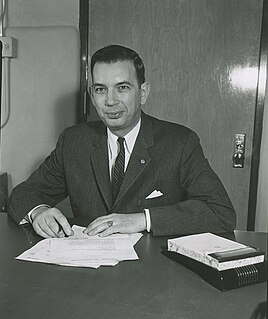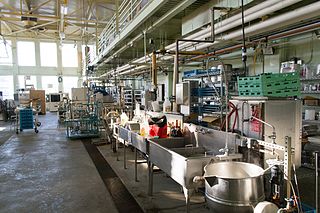
The Agricultural Research Service (ARS) is the principal in-house research agency of the United States Department of Agriculture (USDA). ARS is one of four agencies in USDA's Research, Education and Economics mission area. ARS is charged with extending the nation's scientific knowledge and solving agricultural problems through its four national program areas: nutrition, food safety and quality; animal production and protection; natural resources and sustainable agricultural systems; and crop production and protection. ARS research focuses on solving problems affecting Americans every day. The ARS Headquarters is located in the Jamie L. Whitten Building on Independence Avenue in Washington, D.C. and the headquarters staff is located at the George Washington Carver Center (GWCC) in Beltsville, Maryland. For 2018, its budget was $1.2 billion.

Aronia is a genus of deciduous shrubs, the chokeberries, in the family Rosaceae native to eastern North America and most commonly found in wet woods and swamps. The genus is usually considered to contain two or three species, one of which is naturalized in Europe. A fourth form that has long been cultivated under the name Aronia is now considered to be an intergeneric hybrid, Sorbaronia mitschurinii.

Solanum americanum, commonly known as American black nightshade, small-flowered nightshade or glossy nightshade is a herbaceous flowering plant of wide though uncertain native range. The certain native range encompasses the tropics and subtropics of the Americas, Melanesia, New Guinea, and Australia.
Chi-Tang Ho is a Chinese-born American food scientist. He received his PhD in organic chemistry in 1974 and immediately started working professionally as a researcher and professor in the food science department at Rutgers University. He is now director of the food science graduate program at Rutgers University in New Brunswick, New Jersey.

The Institute of Food Technologists (IFT) is an international, non-profit scientific society of professionals engaged in food science, food technology, and related areas in academia, government and industry. It has more than 17,000 members from more than 95 countries.
Stephen Szu Shiang Chang was a Chinese-born, American food scientist who was involved in the research of lipid and flavors in food, including the development of technology transfer between the United States and Taiwan.
Philip K. Bates was an American food scientist who was involved in the development of food freezing, dehydration, and concentration both in academia and in industry.
Maynard Alexander Joslyn was a Russian-born, American food scientist who involved in the rebirth of the American wine industry in California following the repeal of Prohibition in 1933. Joslyn was also involved in the development of analytical chemistry as it applied to food, leading to the advancement of food chemistry as a scientific discipline.
George F. Stewart was an American food scientist who was involved in processing, preservation, chemistry, and microbiology of poultry and egg-based food products. He also became the first president of the International Union of Food Science and Technology (IUFoST) after it was formed at the 1970 conference in Washington, DC from the International Congress of Food Science and Technology.
The Journal of Food Science is a peer-reviewed scientific journal that was established in 1936 and is published by John Wiley & Sons on behalf of the Institute of Food Technologists in Chicago, Illinois. From 1996 to 2005, it was ranked eighth among impact in scientific journals publishing food science and technology.

Walter Mathias Urbain is a distinguished American scientist who helped pioneer food science through innovative research during World War II. His contributions include new patents and methodologies in food engineering, irradiation, and meat science. Because of his contributions, the US government, especially the US Army and the former US Atomic Energy Commission, developed national programs on food irradiation during the 1950s which led to the development of international standards and the application of his methods on a global basis.
Dennis R. Heldman is an internationally well-known food engineer. He served as president of the Institute of Food Technologists during 2006–2007.
Fred Wilbur Tanner (1888–1957) was an American food scientist and microbiologist who involved in the founding of the Institute of Food Technologists (IFT) and the creation of the scientific journal Food Research.
Bernard J. Liska was an American food scientist who was involved in the creation of the Food Science Department at Purdue University in West Lafayette, Indiana. He also served as President of the Institute of Food Technologists in 1984-85 and was scientific editor of the Journal of Food Science from 1970 to 1981.
Daryl Bert Lund is an American food scientist and engineer who has served in various leadership positions within the Institute of Food Technologists, including President in 1990–1991 and editor-in-chief of the Journal of Food Science from 2003-2012. Lund was named one of 26 innovators in Food Engineering magazine's 75th anniversary edition in September 2003.
Dr. Shridhar Sathe is professor of food science at Florida State University who is widely cited as an authority on the role of proteins in food allergy science. His research program is focused on identifying tree nut allergy proteins, developing antibody-based enzyme linked immunosorbent assays (ELISAs) for their detection and quantification, and identifying and characterizing epitopes in tree nut allergenic proteins. Dr. Sathe has served on USDA NRICGP review panels, several national committees of the Institute of Food Technologists (IFT), and is a frequently sought reviewer by many scientific journals in food science and technology and publishing companies. He is an elected fellow of the IFT. He currently serves on the editorial boards of Journal of Agriculture and Food Chemistry, Journal of Food Biochemistry, LWT-Food Science and Technology, Plant Foods for Human Nutrition, and Korean Food Science and Biotechnology.
Edwin L. Moore was a researcher for the United States Department of Agriculture (USDA). With Louis G. MacDowell and C. D. Atkins in the 1940s, he helped develop a new process for making frozen concentrated orange juice. Moore was inducted into the Florida Agricultural Hall of Fame in 1986 for his contributions to the Citrus Industry and was inducted into the Florida Citrus Hall of Fame in 1983.

Vaccinium ovalifolium is a plant in the heath family having three varieties, all of which grow in northerly regions, including the subarctic.
Hans Lineweaver was an American physical chemist, who reinvented the Lineweaver–Burk plot. The paper containing the equation, also known as the Double Reciprocal Plot, was co-authored by Dr. Dean Burk, and was entitled "The Determination of Enzyme Dissociation Constants (1934)". It remains the most frequently cited paper to appear in the Journal of the American Chemical Society. Linearizations of the Henri-Michaelis-Menten law of enzyme kinetics were important in the era before general availability of computers to determine the parameters Vmax and Km from experimental data, even though there are significant statistical problems involved in this procedure. These are still used for data presentation. All three possible methods of linearization were originally proposed by Woolf, who was unable to formally publish them due to injuries received in a car accident. However, he had discussed them with his close friend and fellow member of the British Communist Party, J. B. S. Haldane, who referred to them in his seminal book on enzyme kinetics. However, the linearizations were largely ignored until they were re-invented by the authors whose name they now bear.










